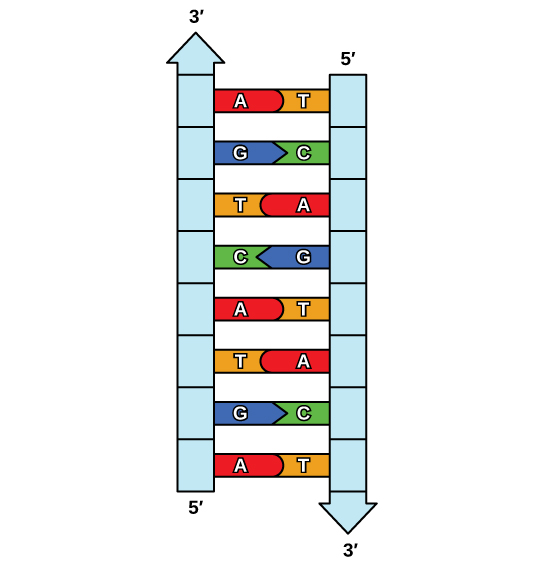
The fundamental structure of deoxyribonucleic acid (DNA) is oftentimes depicted as a twisted ladder or a double helix. This elegant structure is pivotal for understanding the complex genetic blueprint that governs biological organisms. At the core of this architectural marvel lie two essential molecules that form the sides of the DNA ladder. These molecules are deoxyribose sugar and phosphate groups, either of which plays a critical role in maintaining the stability and integrity of the DNA molecule itself. In this guide, we will delve into a thorough exploration of these components, their functions, and their implications within the realm of molecular biology.
The Composition of DNA
DNA is a macromolecular structure composed of nucleotides, which are the building blocks of nucleic acids. Each nucleotide consists of three components: a nitrogenous base, a phosphate group, and a deoxyribose sugar. It is the repetitive linkage of these nucleotides that results in the distinctive double helix configuration. Understanding the intricate relationships between the molecules that constitute the sides of the DNA ladder is fundamental for grasping the larger narrative of genetic expression and replication.
Deoxyribose Sugar: The Backbone Element
Deoxyribose sugar is a five-carbon sugar molecule integral to the DNA structure. Its designation as “deoxy” stems from the absence of one oxygen atom, as compared to ribose, the sugar found in ribonucleic acid (RNA). This subtle difference contributes significantly to the stability of DNA, particularly during replication processes. Structurally, deoxyribose is characterized by a ring formation that allows for efficient molecular bonding, thereby facilitating the connection to both the nitrogenous base and the phosphate group.
As the core component of the DNA backbone, deoxyribose serves as a covalent link, binding via phosphodiester bonds to adjacent nucleotides. These linkages are crucial in establishing the rigidity and overall conformation of the DNA strand. This rigid structure not only safeguards the encoded genetic information but also ensures the proper alignment necessary for replication and transcription.
Phosphate Group: The Stabilizing Agent
In tandem with deoxyribose, the phosphate group forms the alternate side of the DNA ladder. Each phosphate group is composed of a phosphorus atom bonded to four oxygen atoms, and it typically carries a negative charge. This charge plays an essential role in the aqueous environment of living cells, as it contributes to the solubility and interaction of DNA with other biomolecules, such as histones and enzymes involved in DNA replication.
The arrangement of phosphate and deoxyribose creates the sugar-phosphate backbone, providing robust structural support and defining the polarity of the DNA strand. Each end of a DNA molecule has a distinct terminus; one end features a free hydroxyl group (3′ end), while the other concludes with a free phosphate group (5′ end). This asymmetry is paramount for the directional synthesis undertaken by DNA polymerases during replication.
The Sugar-Phosphate Backbone: Functional Significance
The sugar-phosphate backbone is more than a mere scaffold for nucleotide attachment. It functions as a protective casing to shield the nitrogenous bases, which are responsible for genetic coding. This dual functionality enhances the molecular resilience of DNA, allowing it to withstand environmental factors that could otherwise lead to degradation. Furthermore, the orientation of the sugar-phosphate strands contributes to the helical structure, promoting the characteristic right-handed twist of DNA.
Moreover, the backbone is instrumental in the processes of DNA replication and repair. During replication, enzymes unwind the double helix, allowing new nucleotides to pair with exposed nitrogenous bases. The integrity and cohesion of the sugar-phosphate backbone contribute to the fidelity and efficiency of these enzymatic processes.
The Interplay Between Structure and Function
The relationship between the molecular composition of DNA and its functional capabilities is intricate. The stability afforded by the deoxyribose-phosphate framework ensures that the sequence of nucleotides remains intact during cellular division as well as throughout an organism’s life cycle. This steadfastness allows for the faithful transmission of genetic information from one generation to the next, a principle fundamental to heredity.
Additionally, this molecular architecture is integral for the processes of transcription and translation, where DNA serves not merely as a passive repository of genetic information but as an active participant in protein synthesis. The ability to transcribe specific sequences of DNA into messenger RNA (mRNA) is central to expressing genetic traits, thereby underscoring the dynamic interplay between structure and biological function.
Conclusion
Understanding the two pivotal molecules that compose the sides of the DNA ladder—deoxyribose sugar and phosphate groups—is fundamental for any comprehensive study of molecular biology. Their interplay forms a resilient backbone responsible for not only preserving genetic integrity but also facilitating the myriad processes that enliven the genetic code. As we continue to unravel the complexities of DNA and its molecular constituents, we grasp the profound implications that these structures hold in the broader context of life sciences, biotechnology, and genetics.
